
Barrier Canyon Style Rock Art I
Canyonlands National Park
Barrier Canyon Style rock art is the oldest pictography on the Colorado
Plateau. The style is equated with the Archaic Culture. Within the Fremont
culture region it is a distinct style. It is centered near the Green-Colorado
confluence. The type locality is in Barrier Canyon, also known as Horseshoe
Canyon. Because of the importance of the rock art the area was designated
a detached unit of Canyonlands National
Park. The "Great
Gallery" is the type site for the style. The vast Great Gallery murals
represents one of the greatest pictograph sites anywhere. The area is remote
backcountry and the footpath descending into the canyon is steep and rough.
If you hike in watch for well-camouflaged rattlesnakes sunning themselves
on the path.
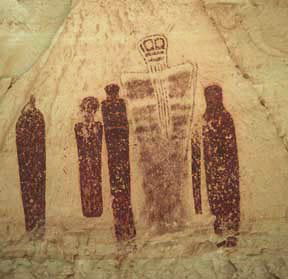
The oldest stratigraphically dated rock art in Utah is an incised pebble from an 8,700 year old level in Cowboy Cave, up canyon from the Great Gallery site. Several petroglyphs are found at Cowboy Cave, including a figure with very enlarged feet. In 1957 Jesse D. Jennings dated the Archaic Native American culture in Danger Cave to 11,000 B.P. Sites in Arizona, New Mexico and Nevada corroborate the antiquity of Archaic culture in the southwest. While some rock art may be as old as human occupation, almost all the art is attributed to recent millennia. |
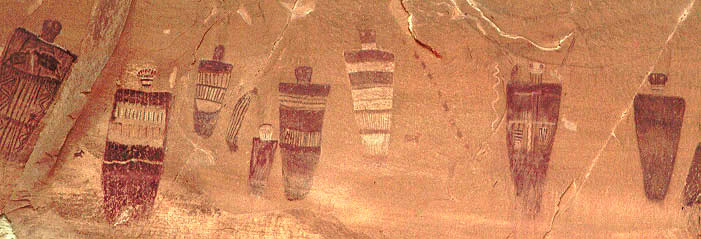
This is only part of the main panel. Here follow several close-ups. |
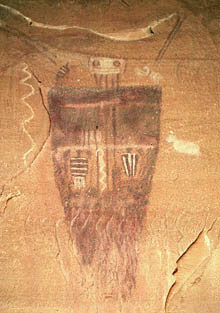
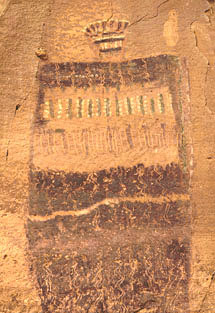
| Barrier Canyon Style is not attributed to recent millennia. The age of
most panels remains indeterminate. The limited information places the
pictography between 2,000 and 4,000 years old. Some of the art is contemporaneous
to Pecos River Style. Some may be older. More dating research is needed.
Features distinct to the style include tiny birds flying about the heads or tiny people and animals perched on the shoulders of life-sized or larger anthropomorphs. The anthros are typically painted in monochrome reds and browns, are often elongated and have diminutive or no appendages. The bodies of most of the Great Gallery life-sized and larger anthropomorphs have extraordinarily decorated torsos with a great variety of patterns. The Great Gallery is by far the most elaborately decorated panel in the style. One figure has animals and another has miniature anthropomorphs painted upon their torsos. The figures are completely devoid of appendages, a feature equated with the oldest examples of the style. Small animals are perched on the shoulders of one figure. Some figures include tiny birds flying about the heads, or tiny people perched on their shoulders facing the ears. Most are painted in monochrome reds and browns. One of the largest figures, the seven-foot-tall "Great Ghost" was painted by spattering, resulting in a seemingly transparent image. The Great Gallery is composed of several distinct panels and areas, not all of which are necessarily contemporaneous. A few faint petroglyphs are present. Another large and distinct Barrier Canyon Style pictograph panel shares the same cliff just to the left of the Ghost and the main panel. This area has a row of lines numbering about 260. Several other panels are located in alcoves down canyon between the Great Gallery and the trail to the road on the west side. One of these is painted with clay slip. Flash flood lines can be seen at this site. There are other Great Gallery pages on the web by John Misage. More Barrier Canyon style panels are found in the Maze District of Canyonlands National Park, about twenty miles from Horseshoe Canyon--if you are a crow. The background graphic of this page depicts part of the "Harvest Scene," so-called on the supposition that the stooped figures are gathering a harvest. The site is also called the Bird Site, a far more certain interpretation of site content. The birds at the site are distinguishing of this composition. The Maze District is far more difficult to access than Horseshoe Canyon. The area is called the Maze for good reasons. I would not recommend hiking this labyrinth of deep meanders to anyone except an experienced redrock canyon navigator with a topographic map. The art is accessible only by long hikes. Without a 4-wheel-drive vehicle the journey is a minimum three day hike in and out from North Point. A thirty foot rope is needed to lower your backpack at a very constricted section of the trail descending into the canyon from the Maze Overlook. Maze Overlook is 4-wheel -drive accessible.
Just below Maze overlook some faint Barrier Canyon images are found. There is a unique scrawled panel up South Fork under an overhang behind some boulders on the right (west of the Chocolate Drops.) The Bird Site is on the opposite side of the Chocolate Drops. Up canyon from the Harvest Scene there is a small petroglyph panel in Barrier Canyon style. I hiked out via Horse Canyon and saw a half dozen rock art sites, though not Barrier Canyon Style and not particularly fascinating art. The trail out of Horse Canyon is via a side canyon just within the park boundary over a mile from Big Water Spring. It was not easy to find. The following table presents portions of the Harvest
Scene site.
|
| There are several panels in The Doll House/Range Canyon area
between the Land of Standing Rocks and Cataract Canyon, south of The Maze.
South of these four more panels are found. Life-sized Barrier Canyon Style
anthropomorphs are found in Range Canyon.
Water sources in the Maze area are not reliable, as I found out the
hard way. In the Needles District of Canyonlands National Park many spectacular rock art panels are protected. A few of these are Barrier Canyon Style. Salt Creek Canyon contains numerous ancient ruins and rock art panels along a 20 mile section of creek. Near Trail Arch and Peekaboo Spring two white pictographs are painted overlaying a very faint Barrier Canyon Style panel. Up canyon, above the jump and the famous red, white and blue "All-American Man" pictograph site, on a high talus at the mouth of Big Pocket a very unique set of small pictographs (photo right) has been identified as Barrier Canyon Style. Devils Lane contains a small pictograph and another panel is found along the road to Elephant Hill. More Barrier Canyon Style images and text can be viewed by selecting the NEXT button. |
     Archaeology
| Astronomy
| Andes | Mesoamerica
| Southwest | Art |
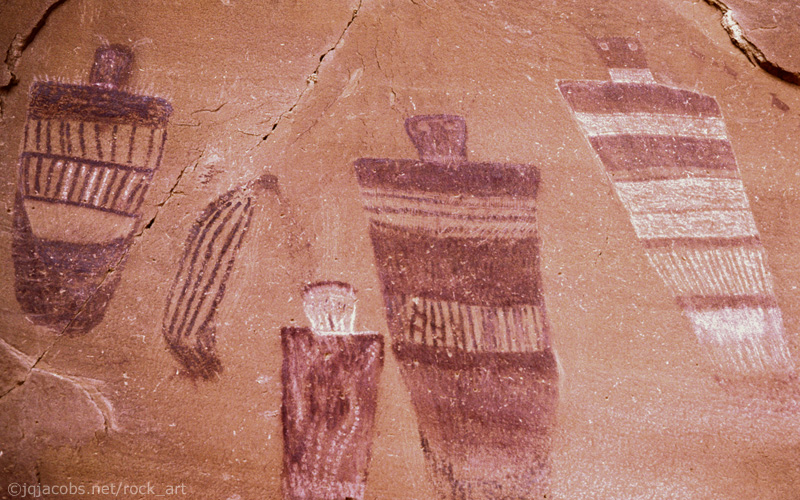
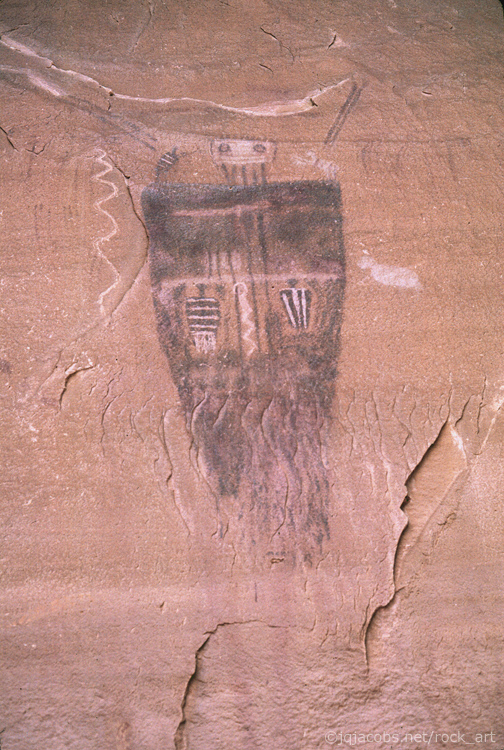


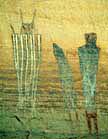
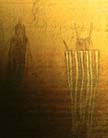
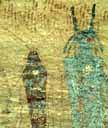
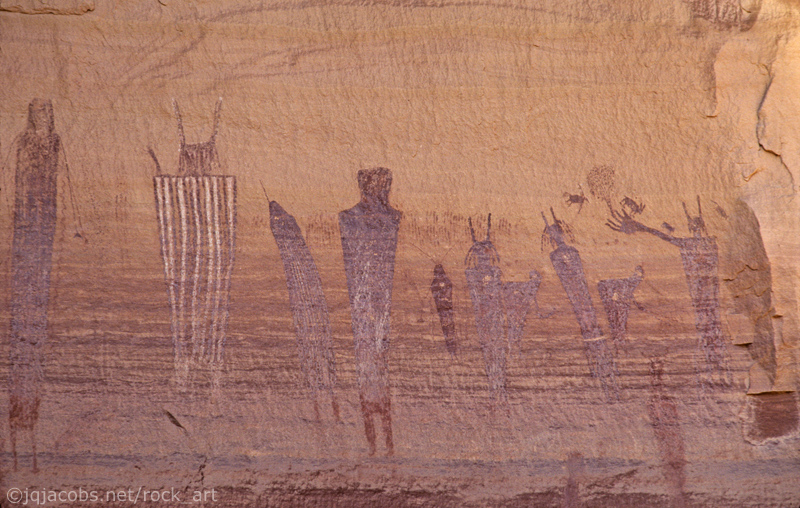
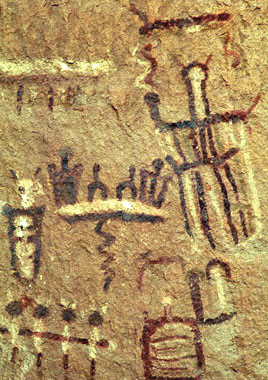 Some
springs were too foul tasting to drink. I was saved from desiccation
because I entered the area just after some heavy showers. After a long
search I found a rock depression filled with a few pints of water on
my third evening out. To prevent other animals from drinking the treasure
I slept right next to it. Although bovines had been banned from the
area for many years, nearby Big Water Spring and the North Trail Canyon
Spring (which I renamed Cow Dung Springs using small pebbles) were both
well trampled smoothies of cow feces and mud. On the plus side, the
night sky is incredible. From this area the nearest bright light bulb
is about 50 miles away.
Some
springs were too foul tasting to drink. I was saved from desiccation
because I entered the area just after some heavy showers. After a long
search I found a rock depression filled with a few pints of water on
my third evening out. To prevent other animals from drinking the treasure
I slept right next to it. Although bovines had been banned from the
area for many years, nearby Big Water Spring and the North Trail Canyon
Spring (which I renamed Cow Dung Springs using small pebbles) were both
well trampled smoothies of cow feces and mud. On the plus side, the
night sky is incredible. From this area the nearest bright light bulb
is about 50 miles away.